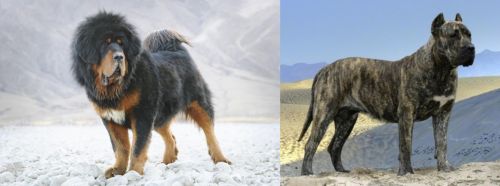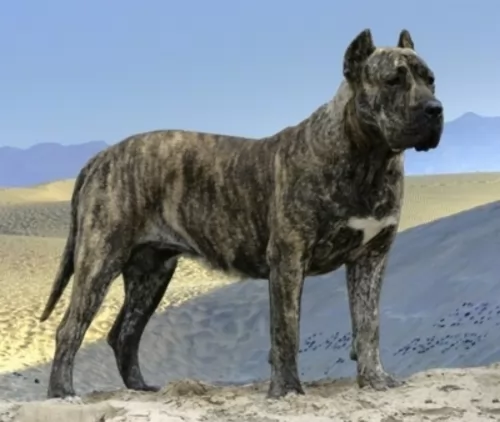 MyDogBreeds
MyDogBreeds Tibetan Mastiff is originated from China but Presa Canario is originated from Spain. Tibetan Mastiff may grow 18 cm / 8 inches higher than Presa Canario. Tibetan Mastiff may weigh 30 kg / 67 pounds more than Presa Canario. Tibetan Mastiff may live 3 years more than Presa Canario. Tibetan Mastiff may have less litter size than Presa Canario. Tibetan Mastiff requires Moderate maintenance. But Presa Canario requires Low maintenance
Tibetan Mastiff is originated from China but Presa Canario is originated from Spain. Tibetan Mastiff may grow 18 cm / 8 inches higher than Presa Canario. Tibetan Mastiff may weigh 30 kg / 67 pounds more than Presa Canario. Tibetan Mastiff may live 3 years more than Presa Canario. Tibetan Mastiff may have less litter size than Presa Canario. Tibetan Mastiff requires Moderate maintenance. But Presa Canario requires Low maintenance
 The Tibetan Mastiff is still considered to be a primitive breed originating in Tibet centuries ago. The breed was developed to guard property and livestock. They still do this as well as being a much loved family dog and a show dog as well. There is very little history that is documented for the breed prior to the 19th century.
The Tibetan Mastiff is still considered to be a primitive breed originating in Tibet centuries ago. The breed was developed to guard property and livestock. They still do this as well as being a much loved family dog and a show dog as well. There is very little history that is documented for the breed prior to the 19th century.
Believed to be centuries old with ancestors who are mastiff like dogs that developed into two different types of Tibetan Mastiffs. These types are the Tsang-Khyi and the Do-Khyi. The Tsang Khyi were guardians for Tibetan monks, while the Tsang-Khyi guarded flocks for nomadic shepherds and in villages.
The first Tibetan Mastiff was imported in 1847 to England and presented as a gift to Wueen Victoria, from India’s Viceroy. By 1873 there was an English Kennel Club and the breed was labeled a large dog from Tibet and entered into the EKC Stud Book.
The next year the future King Edward VII, brought another two Tibetan Mastiffs to the United Kingdom to show in 1875. The first breed club began in 1931. The world wars interfered and no new dogs were imported to England until 1976. Two dogs were given to the President of the United States in the late 1950’sbut were not bred and it wasn’t until 1970 that any more were imported. The US Tibetan Mastiff Club was not founded until 1974 and they were first entered in a National Specialty show in 1979.
In 2007 the AKC recognized the breed as a working dog since 2007. It’s hard to find a purebred Tibetan Mastiff in Tibet anymore.
 Known also as the Canary Mastiff, the Presa Canario hails from the Canary Islands. He was originally bred for guarding livestock.
Known also as the Canary Mastiff, the Presa Canario hails from the Canary Islands. He was originally bred for guarding livestock.
This isn’t a new breed by any means, and it is believed that the dog dates back to the 15th and 16th centuries. The roots of the dog can be traced back to the Iberian Presa, a medium sized mastiff breed. A number of other Hispanic breeds have contributed to the formation of the Presa Canario, such as the Presa Espanol.
Its numbers have dropped over the years, but in the 1970s, reputable breeders bred Presa Canarios, a courageous, territorial dog.
Because of its aggressive tendencies, the dog has been banned from quite a few countries. It is found in the USA but not recognized by the American Kennel Club.
 Both types of Mastiffs can be present in the same litter, so that both larger and smaller pups are present. Both types are well-muscled and structured. Today’s dogs being developed in China and the West are much larger than the previous ones. These dogs would be less useful to the nomads and cost too much to feed. Today’s dog is very large with a large head and a long double coat. This coat can be black, brown, gold, and blue, with or without tan markings. There are now a few white Tibetan Mastiffs being bread.
Both types of Mastiffs can be present in the same litter, so that both larger and smaller pups are present. Both types are well-muscled and structured. Today’s dogs being developed in China and the West are much larger than the previous ones. These dogs would be less useful to the nomads and cost too much to feed. Today’s dog is very large with a large head and a long double coat. This coat can be black, brown, gold, and blue, with or without tan markings. There are now a few white Tibetan Mastiffs being bread.
The breed standard for the Mastiff is different in the West than in the East. In the East the breed is broken into two categories – the Lion Head and the Tiger head.
 The Presa Canario is a large Molosser-type dog breed originally bred for working livestock.He stands at between 56 to 65cm in height and weighs between 38 and 60kg. He has a thick, muscular body with a black mask over the broad head.
The Presa Canario is a large Molosser-type dog breed originally bred for working livestock.He stands at between 56 to 65cm in height and weighs between 38 and 60kg. He has a thick, muscular body with a black mask over the broad head.
The ears were always cropped which just added to his aggressive appearance. When left they are high set and floppy, being of medium length. The coat is short and coarse and he is a low shedder. The coat comes in colors such as fawn, tan, or brindle.
Strong willed, confident and determined, the Presa Canario may well have an intimidating look.He looks both powerful and even a bit aggressive, but with training and socialization, the highly intelligent Presa Canario is actually a calm, docile dog, totally loyal and loving with his human family.
These dogs are suspicious of strangers and this makes them excellent watchdogs. For new dog owners, the Presa Canario isn’t a good first choice as he is strong-willed and can be aggressive when in the wrong hands. There are however, always exceptions, but he isn't considered to be a good choice of dog when there are children in the home.
 The Presa Canario is a formidable looking dog and has received quite a lot of negative media attention for being aggressive and dangerous. And yet non-aggressive owners who have brought the dog up properly tell of how well mannered and calm their dogs are.
The Presa Canario is a formidable looking dog and has received quite a lot of negative media attention for being aggressive and dangerous. And yet non-aggressive owners who have brought the dog up properly tell of how well mannered and calm their dogs are.
The dog is confident and powerful and can be loyal and loving while also being well adjusted. Just like children are the fruit of their parents upbringing, so dogs turn out much the same as the kind of owners that reared them, and in the right hands, this big dog can be loyal quiet, loving and trustworthy.
 Though considered a primitive dog and isolated for several centuries, so they should not have as many genetic or inherited conditions as other dogs with more cross and in-breeding. These are the potential health issues they might develop:
Though considered a primitive dog and isolated for several centuries, so they should not have as many genetic or inherited conditions as other dogs with more cross and in-breeding. These are the potential health issues they might develop:
Elbow and Hip dysplasia – can lead to lameness and arthritis.
OCD Osteochondrois Dissecans – this is also an orthopedic condition when the soft tissue growth is abnormal in the joints. It is painful and the joint is stiff. Don’t breed a dog that has this condition.
Panosteitis – Canine growing pains. Inflammation of the long bones in large dogs as they grow. They will eventually out grow it. Pain can be managed through medication.
Autoimmune Hypothyroidism – Hormone deficiency leading to flaky skin, weight gain and lack of energy. Can be managed through medication.
Canine Inherited Demyelinative Neuropathy – If your Tibetan Mastiff is going to have this condition, they will have it by six weeks of age. Weakness in the hind legs leading to paralysis.
Bloat – deadly if not treated immediately and related to dietary habits.
 These are large dogs so they are susceptible to hip- or joint dysplasia and canine leishmaniasis.
These are large dogs so they are susceptible to hip- or joint dysplasia and canine leishmaniasis.
This is a skeletal condition, found more often in large dogs. The ball and socket don’t fit properly, grinding as opposed to sliding smoothly. This eventually leads to loss of function of the joint.
There are a few factors that lead to the development of hip dysplasia in dogs, but it is also hereditary. That is why it is so important to provide your dog with the correct nutrition – one that is specially formulated for large breeds.
This is a deadly disease caused by a protozoan parasite found in dogs, mostly in rural areas, and in quite a few areas of the world.
The parasite is transmitted by a sand fly. The clinical signs of dogs with this disease include weakness, fever, swollen lymph nodes, anorexia, weight loss and diarrhea with blood in the stools.
Treatment will require the administration of a special drug. Prognosis for a pet diagnosed with Leishmaniasis is unfortunately not very hopeful.
 Don’t feed the puppy too much protein as you want to prevent Panosteitis and growing too quickly. Do not overfeed. Feed 4-5 cups of high quality large breed puppy food in 3-4 meals day.
Don’t feed the puppy too much protein as you want to prevent Panosteitis and growing too quickly. Do not overfeed. Feed 4-5 cups of high quality large breed puppy food in 3-4 meals day.
4 to 6 or more cups of a high-quality dog food daily, divided into two meals. To avoid bloat do not feed before or after vigorous exercise.
Calm and laid back when inside.
They need 20-30 minutes of vigorous exercise and play daily. They prefer to play with other large dogs.
 The Presa Canario will require being brushed twice a week to rid him of loose hair although he isn’t a heavy shedder.
The Presa Canario will require being brushed twice a week to rid him of loose hair although he isn’t a heavy shedder.
Keep his nails trimmed.
Check inside his ears for signs of redness and the possibility of an ear infection.
When you brush him, check him over for any unusual lumps.
Make sure the dog is neutered or spayed if you don’t want puppies.
Get your vet to the vet if he shows signs of illness.
Make sure his vaccines are up to date to prevent some deadly canine diseases.
Ensure he has a nice comfortable, dry, warm place to sleep.
Ensure he has a top quality diet to enhance longevity and health. Commercially manufactured dog foods are a convenient means to feed your pet, and there are some excellent brands. Avoid the ones with low quality ingredients that don’t have the right balances of vitamins and minerals.
High quality dry kibble can become exciting when you add in some home-made food. Dogs thrive on simplicity, so boiled chicken, sweet potatoes, brown rice or pasta, carrots and spinach will be 100% sufficient for him. Chop this food up and add it into the dry kibble twice a week as a tasty treat.
Also, your pet will thrive on a bit of raw meat added in from time to time. Make sure he is never without a constant supply of fresh, cool water.
Make sure that your large pet gets a good quota of daily exercise outdoors. Lots of hectic ball- and rope games will keep him happy and keep him slim. Take him for a walk every day.